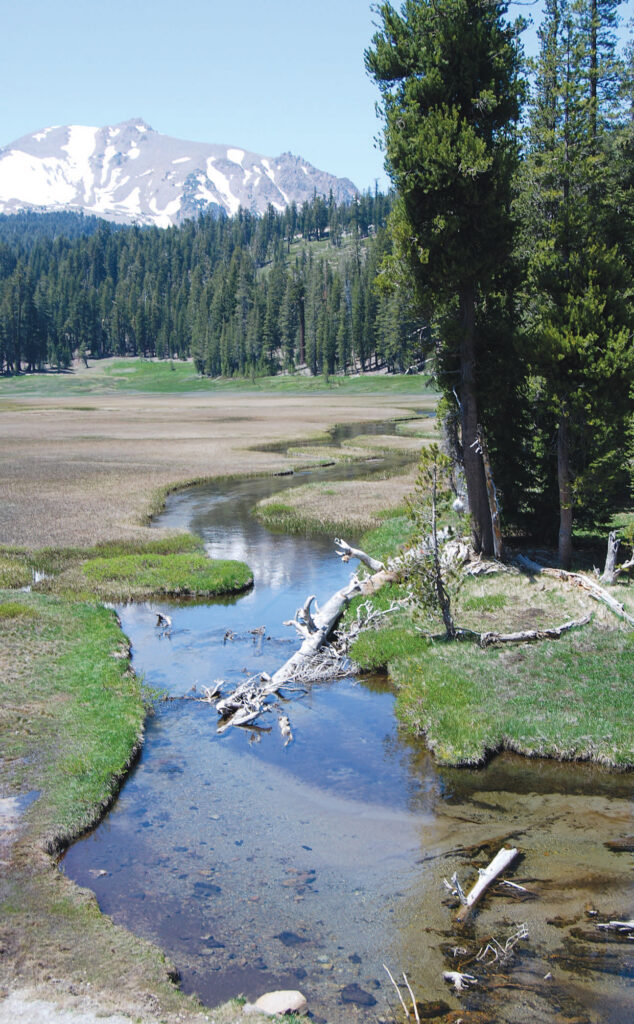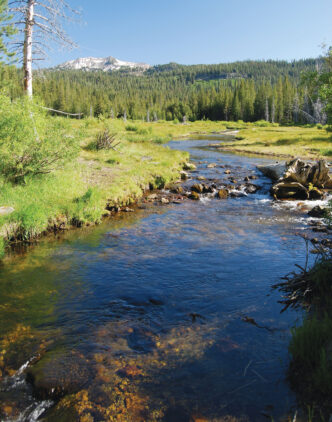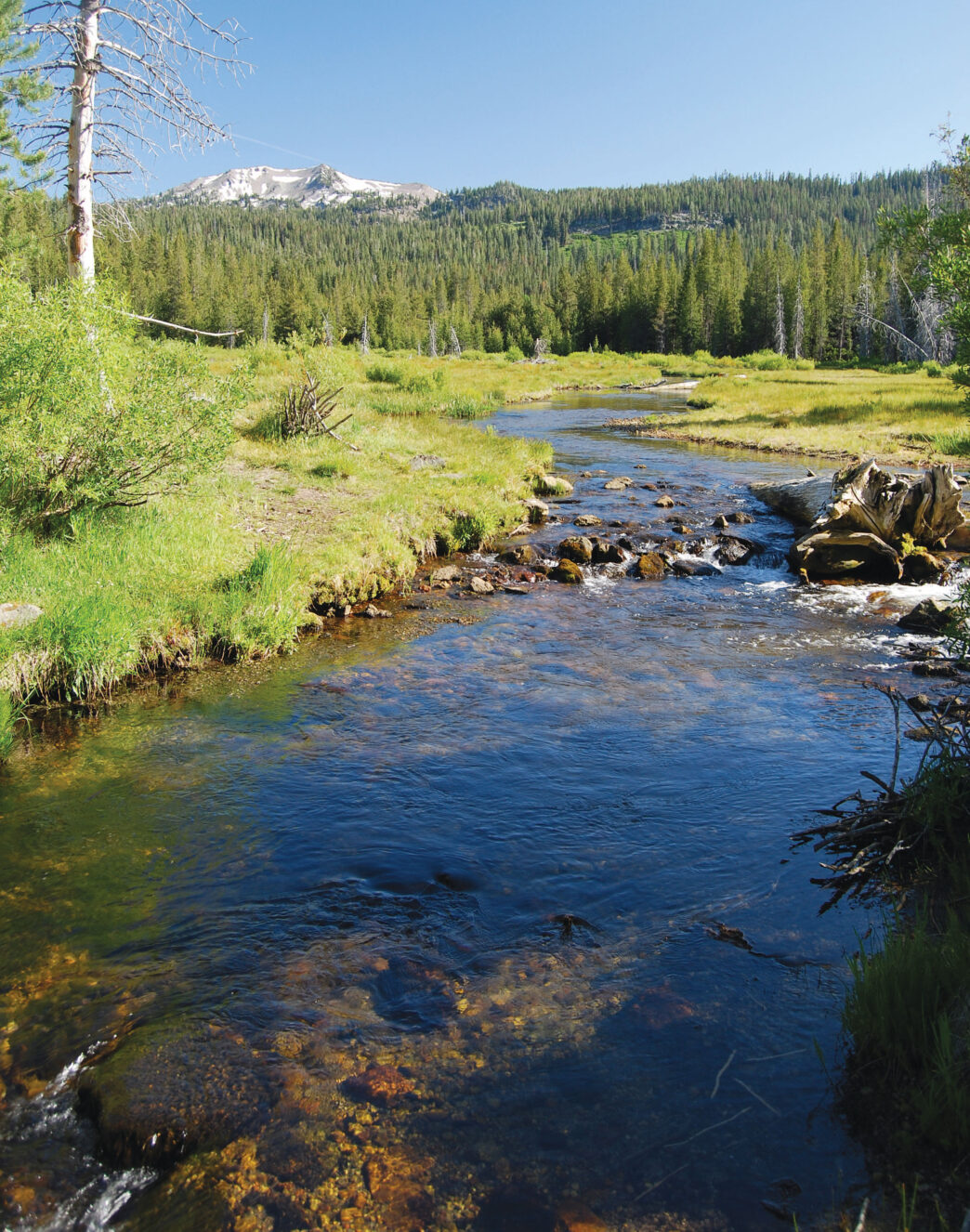In 1907, America’s preeminent conservationist, President Theodore Roosevelt, designated Lassen Peak and Cinder Cone as national monuments.
Then, in May 1914, Mount Lassen erupted and continued to do so for the next three years, during which time Lassen Peak and Cinder Cone and their surroundings were combined and granted national park status. Today, Lassen Volcanic National Park (or just Lassen National Park) stands as one of the nation’s prettiest, if less visited parks.
Many fly fishers are familiar with the park’s principal attraction for anglers, Manzanita Lake. (See the sidebar for more on that particular water.) Lassen, however, offers other opportunities for fishing. The focus of this article are two smallish streams, Kings Creek and Upper Hat Creek, that are located within beautiful settings. Each holds an abundance of brook trout, as well as an occasional rainbow or brown. Access to each could not be easier.
The Park’s Trout
A handful of creeks that originate in or near the park, such as Hat Creek, Mill Creek, Deer Creek, and the North Fork of the Feather River, are part of the Sacramento River watershed, either as a direct tributary or as a feeder stream to one, so it’s likely that native rainbows got established in Lassen’s waters eons ago. But rainbows were also widely planted in the park, along with the brook and brown trout, later to become self-sustaining populations. This is likely true for Manzanita Lake, too. In fact, Eastern brook trout, a species that was introduced throughout the West, are now the primary trout species occupying all of Lassen’s creeks and many of the lakes. German brown trout, another introduced species, also are found in park waters, especially in Manzanita. Since brookies and browns are capable of outcompeting native rainbow trout, they often come to dominate waters where the rainbow came first.
Lassen, along with other national parks, stopped stocking fish in the 1970s and 1980s in order to reemphasize the natural values of these special places. So today, whatever species you catch in Lassen, it will be a wild trout.
Kings Creek
Kings Creek is the longest waterway in the park, flowing from the slopes of Mount Lassen all the way to the Warner Valley, near the town of Chester. Some small-creek aficionados have tried to keep this creek and its abundant brook trout population a secret, at least the small part meandering in the meadow alongside Highway 89. While it’s true that the fishing experience there would suffer qualitatively from angling pressure, the fishery itself probably would not. Brook trout have the ability to overpopulate a creek or lake quickly, leading to a lot of small fish. Reducing the population, or keeping it from increasing, usually helps the fishery. So one should not feel guilty about keeping brook trout for the frying pan. In my view, brookies are the tastiest of all trout species. The Kings Creek meadow is free of foliage, so the fly fisher’s challenge is to get into position to cast without spooking trout that are easily spooked. Targeting one’s prey and having it take your fly is the ultimate test. Blindly casting to a good-looking piece of distant water and seeing what happens is another fun tactic. The choice of fly really is secondary. Fishing a small dry so one can see the take is surely the most entertaining approach. Catching a trout in Kings Creed meadow over 7 inches would be like hooking a 16-incher from Manzanita.
After leaving the meadow under Highway 89, Kings Creek has a long run of several fishable miles, although the dominant reason for almost all visits to this stretch is to see Kings Falls and its 50-foot drop. To reach the falls, hikers and anglers alike depart from the trailhead at Highway 89 across the road from Kings Creek meadow. It’s about 1.2 miles to the falls. Part of this trail is steep and rocky, particularly in the Kings Creek Cascades gorge. A slightly longer horse trail of 1.5 miles is less steep.
Crashing pocket water dominates this part of Kings Creek. Typically, greater numbers of brook trout occupy the slower water in meadows than in gushing runs and drops. But locate a pool with holding water along the trail to the falls, and you can probably hook one or more trout.
From the falls, most hikers walk back to the trailhead as part of a loop trail. One trail, however, continues past the falls and follows Kings Creek for several miles through Corral Meadow and the Warner Valley before leaving the park.
Upper Hat Creek
Fly fishers of course know Hat Creek as one of the blue-ribbon trout waters in California. Less well known, perhaps, is that its headwaters begin at the base of Mount Lassen.
Hat Creek in the park is a superb brook trout stream, with a long, 6-mile run that begins on the opposite side of Mount Lassen from Kings Creek. The best access is where Highway 89 crosses it at “Hat Lake,” about 15 miles from the western entrance station. Here, one can take a trail either up or down along the creek. Upstream, upper Hat is mainly a meadow creek at first; downstream, it is mainly a freestone creek. Both parts will give up brook trout, with better fishing in the upstream meadow stretch.
A parking area and trailheads are by the highway. To fish upstream, just start walking the trail and veer off to the creek at any time. The choice runs are in the first half mile. Here, many runs flow among groves of willows, and there is surprisingly good access to the water. On a quick fishing stop in June, I brought in one beautiful nine-incher, which I kept for what was supposed to be a two-fish dinner that evening for my wife and me. Two more of similar size came from the depths and made a faux pass at my fly. I finally had to settle for one of about six inches to fill out our main course.
After about half a mile, the trail gets steeper as it climbs the mountainside. The stream cascades down through the woods, dropping in one place to create a modest waterfall.
On the other side of the highway, Hat Creek flows through a modest canyon. The best access to it is via a dirt road with a locked gate up from the parking area. Proceed down the road a short distance to the creek and fish it as far downstream as you wish. You’ll find nice-looking pocket water throughout the few miles to the very boundary of the park.
My wife and I introduced our two granddaughters to backpacking in this area a few years back. We walked about a quarter of a mile down the road to the stream, where we set up camp. While they played in the creek, I hooked two small, but pretty brookies in water that looked like it should have given up more.

Other Lassen Streams
The other streams that flow throughout Lassen all probably hold brook trout where flows don’t dry up, a primary consideration in this drought-stricken year. A promising possibility is East Sulphur Creek, which joins with Bumpass Hell Creek to form Mill Creek Falls, the highest and prettiest waterfall in the park, with a drop of 75 feet. One can hike on good trails to this waterfall, either down from the north (near the trailhead to Kings Creek Falls), a distance of 3.3 miles, or up from the southwest entrance, a hike of about 1.8 miles. Two cars or a shuttle can provide for a straight-through trek in either direction. Expect to see an abundance of wildflowers, as well as picturesque lakes, including the singular Cold Boiling Lake — a name that truly means what it says.
West Sulphur Creek comes in farther down from Mill Creek Falls to form Mill Creek, which leaves the park and eventually flows into the Sacramento River. lower Mill Creek holds a small, but critical run of spring-run salmon, as well as steelhead, so this is an important waterway. It offers good fishing outside of the park on its long journey to the Sacramento.
The other creek worth a special visit is Grassy Creek, which connects Snag Lake and Horseshoe Lake in the southeastern part of the park. Both Grassy Creek and Horseshoe Lake reportedly hold brook, brown, and rainbow trout. Horseshoe, which is about a mile walk from caraccessible Juniper Lake, is touted as the “second best fishing lake” in Lassen after Manzanita.
Manzanita Lake
When temperatures in the Central Valley hit the high 90s and on up to triple digits, my wife and I often head up to Manzanita Lake, which is less than an hour’s drive from where we live and reliably is 25 degrees cooler. This is also one of my favorite waters to fish, for all of the well-known reasons. (See Chip O’Brien’s article in the May/June 2014 issue of California Fly Fisher). I regularly refer to it as the best wild-trout lake in the country, confident of this rating without even knowing that many other lakes.
I’ve recently learned that the California Department of Fish and Wildlife will take over management of Manzanita. This is very good news, since Lassen Volcanic National Park does not have a fishery biologist on staff, and despite my glowing tribute, the lake could benefit from professional management, in my view.
My (unscientific) assessment is that Manzanita suffers, if that’s the right word, from too many brown trout. For example, in an outing this past May, I (uncharacteristically) hooked around 14 fish one afternoon, all browns. More disturbing, however, was that the three specimens over 17 inches were about two inches in girth. (In New Zealand, such a skinny trout is called a “slab.”) Hooking one of these malnourished fish at first seems like a good catch, until it quickly loses its fight. When I hook a sizeable rainbow at Manzanita, it more often is a healthy specimen, although I do occasionally bring one in that is too thin. (These informal findings, which have been replicated many times by me and other anglers, discount “spawned-out” fish.)
So I urge the CDFW to manage this lake to bolster the all-important native rainbow trout fishery and to increase the proportion of its population in the lake. If the extraordinarily high fish biomass in this lake exceeds its ability to support it, which is a distinct possibility, perhaps some regulations can be implemented to cull the ever-growing numbers of brown trout.
Bob Madgic
















